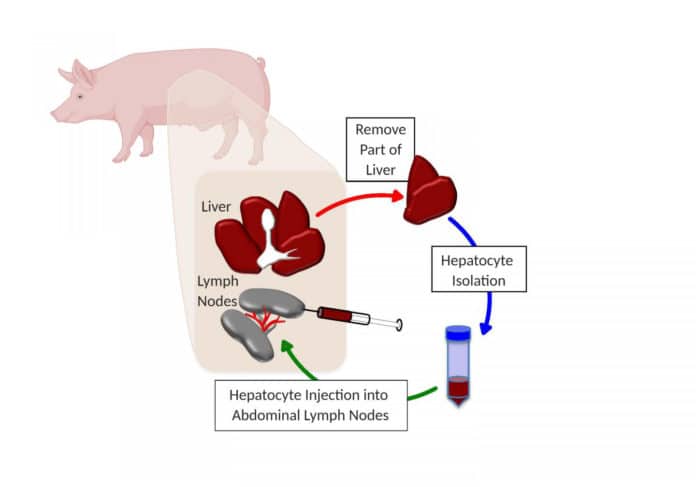A hepatocyte is a cell of the main parenchymal tissue of the liver. Hepatocytes make up 55-65% of the liver’s mass. Moreover, hepatocytes are natural regenerators, which are multiplied in lymph nodes.
In a new study by the University of Pittsburgh, scientists have shown that large animals with ailing livers can grow a new organ in their lymph nodes from their hepatocytes.
Location plays a vital role. If hepatocytes get in the right spot and there is a need for liver functions, they will form an ectopic liver in the lymph node.
Usually, liver cells replenish themselves, but they need a healthy, nurturing environment to regenerate. However, in end-stage liver disease, the liver is bound up by scar tissue and too toxic for the cells to make a comeback.
Eric Lagasse, Pharm.D., Ph.D., associate professor of pathology at Pitt, said, “The liver is in a frenzy to regenerate. The hepatocytes try to repair their native liver, but they can’t, and they die.”
Almost a decade ago, Lagasse and colleagues noticed that injecting liver cells into the lymph nodes of a mouse resulted in an auxiliary liver to take over the animals’ genetically induced malfunctioning liver.
But mice are small. Lagasse and colleagues needed to show that a large animal could grow a meaningful mass of secondary liver tissue to overcome the liver disease.
To mimic human liver disease in pigs, the researchers diverted the main blood supply from the liver, and at the same time, they removed a piece of healthy liver tissue and extracted the hepatocytes. Those liver cells were then injected into the abdominal lymph nodes of the same animal they came from.
All six pigs showed a recovery of liver function, and close examination of their lymph nodes revealed not only thriving hepatocytes but also a network of bile ducts and vasculature that spontaneously formed among the transplanted liver cells.
The auxiliary livers grew bigger when the damaged tissue in the animals’ native liver was more severe, demonstrating that the animals’ bodies are keeping up a harmony of liver mass instead of having runaway growth akin to cancer.
In this way, regardless of the cause of liver disease, from hepatitis to alcoholism, Lagasse expects growing auxiliary livers in the lymph nodes will help.
Journal Reference:
- Paulo Fontes et al. Development of Ectopic Livers by Hepatocyte Transplantation into Swine Lymph Nodes. DOI: 10.1002/lt.25872
